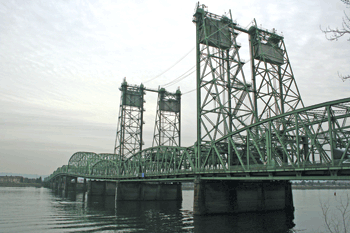According to Nancy Boyd, Washington project director for Columbia River Crossing (CRC) project, the bridge design phase is now complete, and they are in the permitting/preconstruction phase – which includes finalizing funding. The final phase is construction itself.
“Other highway locations, or other drastically different designs,” said Boyd, are not really being considered. “We already have federal confirmation about how to move forward. This project is the culmination of regional planning and solving highest priority problems.”
The federal confirmation Boyd spoke of is the official “federal record of decision” reached in December 2011. This was the culmination, she said, of seven years of brainstorming, evaluating many different ideas and alternatives, and a lot of public involvement.
“A lot of the questions we get now were covered and studied early on and weighed against each other,” said Boyd. “The public process enabled us to refine the design to what it is today.”
However, not everyone is as complacent about the current design. In particular, the height of the bridge is a major bone of contention among some area business owners.
“Greenberry Industrial is in favor of a new Columbia River bridge,” said Dan Rubin, Greenberry spokesman. “However, Greenberry currently delivers large fabricated projects under the existing Interstate Bridge with its 178-foot height, and some projects barely clear the span.”
The current design calls for a height of 116 feet, which Boyd said “impacts something less than seven vessels, one of which isn’t even built yet.” She also said the CRC staff is “still working on mitigation plan for impacted users, and is in close communication with three metal fabricators and marine contractors.”
However, Tom Hunt, communications representative for Thompson Metal Fab (TMF), questions whether there is “sufficient mitigation to keep TMF in business,” adding that “moving was definitely an option.”
Businesses such as TMF and Greenberry represent large chunks of the local economy. Hunt said that TMF employs more than 250 employees in Clark County, with an annual payroll $16.2 million. He estimates this business creates another 215 jobs at other Clark County businesses, worth about $8.9 million. With more than 700,000 square feet of fabrication space, TMF ships about $76 million worth of metal structure projects per year, and supports another $25.8 million in business revenue throughout Clark County.
“Between 2009 and 2011 we had three big projects that we estimate brought $500 million to the community,” said Hunt.
Greenberry, too, has given Clark County’s economy a shot in the arm since their arrival in Vancouver in 2010. Rubin said that in 2010, they employed 200 total employees and revenue was $33 million. Currently, they have about 500 employees (175 here in Vancouver), and revenue has grown to $185 million.
“Reducing the clearance for marine traffic from 177 to 116 feet would be a disaster for major Clark County businesses,” stated Clark County Commissioner David Madore.
Besides the imminent impact on the business, Hunt said the 116-foot clearance was extremely short-sighted.
“We’re building a bridge for the next 100 years, and everything on the river is getting bigger. Everyone who uses it will tell you that,” said Hunt. “In 2006 we said we needed 125 feet – today we’d tell them we need 150 feet.”
The height controversy is in part related to the light-rail component of the project, which Boyd said was part of the 2011 federal record of decision – making it conditional for federal funding of the project. However, Americans with Disabilities Act (ADA) requirements limit the access slopes, which in turn limits the bridge height.
Scott Patterson, C-TRAN’s director of development and public affairs, said that in light of the bond failure last November, they are “in the mode of determining next steps.” He said a board workshop was scheduled for late February. Boyd said that light rail construction is covered by the federal grant, and the CRC is looking for $2 to $5 million per year for operational and maintenance funds.
“In the general scheme of things, we have time to figure it out, and will be doing what we can to work with C-TRAN to provide what they need,” said Boyd.
In the meantime, added Boyd, the CRC staff is engaged in working with the Oregon and Washington legislatures, to provide the information they need to make funding decisions relating to the project.
“We’re anticipating a lot of robust discussion in the Washington Legislature,” said Boyd. “There’s a lot of tension and increased feeling that the federal funding component is ‘ready’ – we need to move ahead so we don’t lose out on that.”
Pre-construction work has included drilling test shafts. Boyd said the foundation will be 200 feet (much deeper than the current bridge). According to Boyd, by drilling shafts and instrumenting them, engineers can be more precise when doing calculations, potentially saving millions in cost overruns.
The goal, said Boyd, is to have all pre-construction documents in place within about a year, so that the project can get under contract by the end of 2014, providing the funding pieces fall into place.
But will the bridge that gets built be right for the community?
“TMF company president John Rudi is a strong supporter [of the CRC project] right up until they put us out of business,” said Hunt. “They are not looking very far over the horizon.”
Rubin put it this way: “If an undersized bridge is built, major companies that commission [massive fabricated structures] will simply take their manufacturing needs elsewhere, eliminating many jobs and the economic benefits for the region, permanently.”






